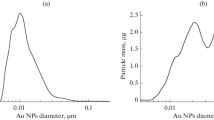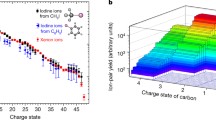Abstract
The fragmentation of gallstones and kidney stones using pulsed visible laser radiation has recently been demonstrated; however, the fragmentation mechanism is not well understood. The temporal and spectral characteristics of the bright flash of light accompanying fragmentation of gallstones were studied using 0.8 and 360-μs-long, 690-nm-wavelength, dye-laser pulses. Time-resolved visible emission spectra show a broad continuum upon which line spectra are superimposed. The continuum emission is due to free-free and free-bound electron transitions indicative of a plasma and the line spectra are due to neutral and ionized calcium. Initiation of this plasma is fluence rather than intensity dependent. A model is proposed in which laser energy is coupled to the plasma, which then impulsively expands, generating intense acoustic transients which fracture the stone.
Similar content being viewed by others
References
N.S. Nishioka, R.R. Anderson: Gastrointest. Endosc.32, 157 (1986)
G.M. Watson, S.L. Jacques, S.P. Dretler, J.A. Parrish: Lasers Surg. Med.5, 160 (1985)
S.P. Dretler, G.M. Watson, S.C. Murray, J.A. Parrish: Lasers Surg. Med.6, 191 (1986)
S.E. Silvis, J.E. Siegel, R. Hughes, R.M. Katon, C.E. Sievert, M.V. Sivak: Gastrointest. Endosc.32, 155 (1986)
R.C. Weast: CRC Handbook of Chemistry and Physics 66th edn. (CRC Press, Boca Raton, FL 1985)
P.W. Merrill:Lines of the Chemical Elements in Astronomical Spectra (Carnegie Institution of Washington Publication 610, 1956)
J.F. Ready:Effects of High-Power Laser Radiation (Academic, New York, 1971)
H.R. Griem:Spectral Line Broadening by Plasmas (Academic, New York 1974)
G. Bekefi:Principles of Laser Plasma (Wiley, New York 1976) p. 566
In estimating electron densities, the effect of quasistatic ion broadening was assumed to be unimportant, the electronimpact widths were assumed to be relatively independent of electron temperature and were averaged over the temperature range 10,000–40,000 K
L.J. Radziemski, D.A. Cremers, T.M. Niemczyk: Spectrochimica Acta40B, 517–525 (1985)
C.E. Bell, J.A. Landt: Appl. Phys. Lett.10, 46–48 (1967)




